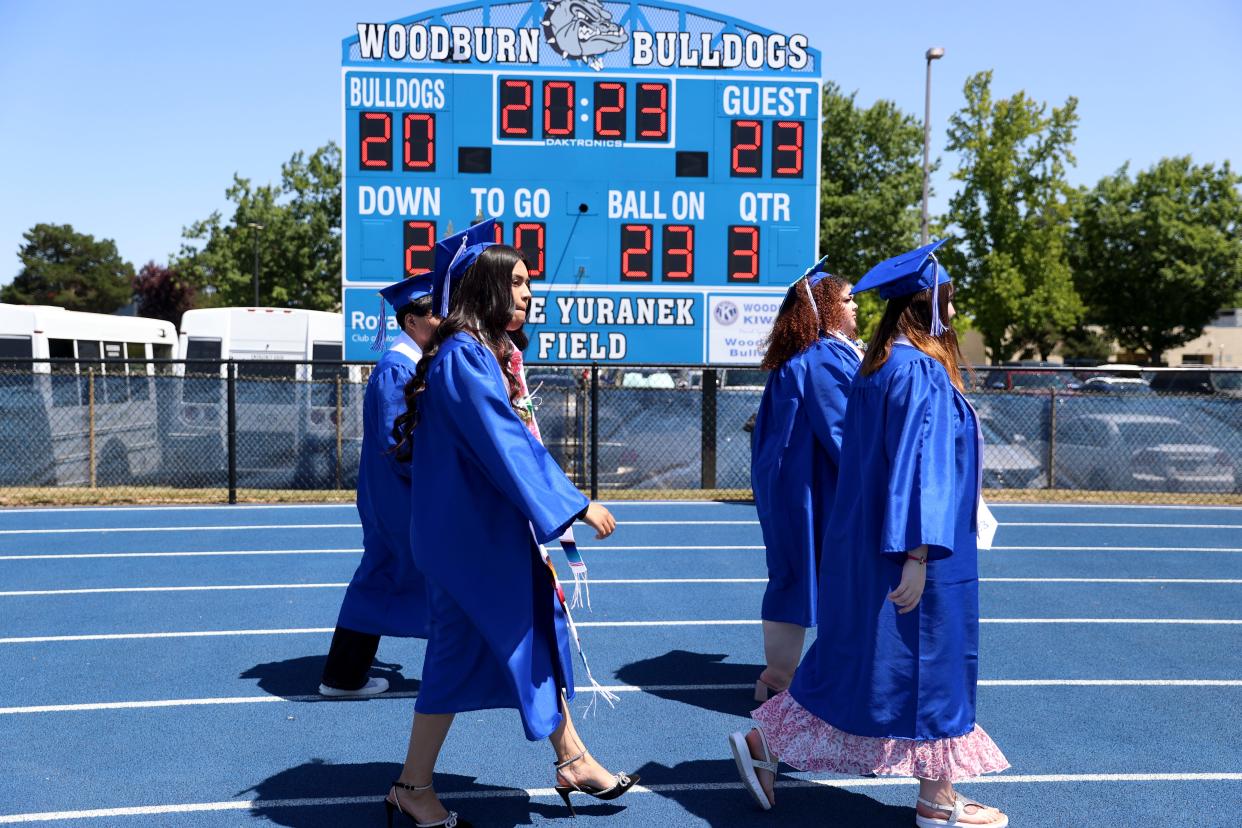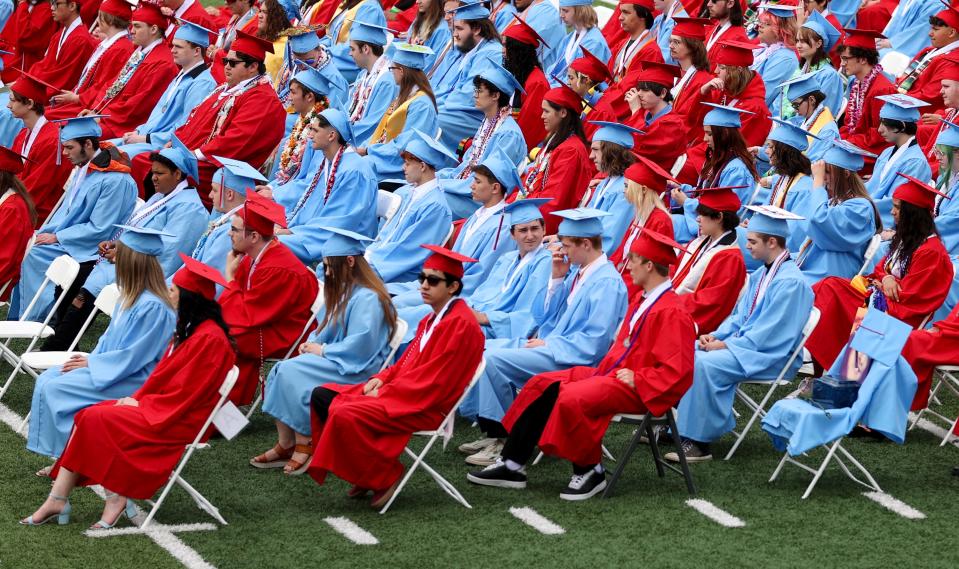US News & World Report reveals top 25 Oregon high school rankings

U.S. News & World Report has released its annual ranking of top high schools in the nation and each state.
Two local schools were among the top 25 Oregon schools, with Woodburn Academy of Art, Science and Technology ranking third, and South Salem High School ranking fifth.
Other Mid-Valley schools that made it into the top 100 in the state include:
Perrydale School in Amity, 23rd.
Philomath High School, 24th.
John F. Kennedy High School in Mt. Angel, 26th.
West Albany High School, 31st.
St. Paul High School, 37th.
Silverton High School, 41st.
Molalla High School, 57th.
West Salem High School, 60th.
Sprague High School in Salem, 61st.
McNary High School in Keizer, 73rd.
McMinnville High School, 77th.
Cascade Senior High School in Turner, 94th.
School rankings are based on 2020-2021 school year math, reading and science proficiency, the four-year graduation rate, college exam performance, and the college readiness index, which is measured by the proportion of a school's 12th graders who participated in and passed Advanced Placement or International Baccalaureate exams. The CRI weighed heaviest on the ranking.
The ranking also takes into account the performance of students in historically underserved communities, including students who are Black, Hispanic and low-income.
But researchers say the rankings don't give parents the full story and top-ranked schools are more often located in wealthier areas.
For example, neighborhoods serving South Salem High School have median incomes higher than the city and state medians, according to U.S. Census data. And the only two high schools in the Salem-Keizer Public Schools district not to break the top 100 are North Salem and McKay, which both include more lower-income and diverse populations than the district's other high schools.
"What they're really doing is measuring opportunity," Josh Cowen, a professor of education policy at Michigan State University, said of the rankings, which typically arrive every year to an avalanche of attention and headlines.

Some of the schools are also more rigorous by design, and not intended to serve every student. The top-ranked school in Oregon, for example, was International School of Beaverton. The school ranked 14 nationally and was the only Oregon school in the national top 25.
At that school, every student studies a foreign language, either Mandarin, Japanese or Spanish. The school also uses the International Baccalaureate program, which focuses on critical thinking, with 98% of its students participating in IB and 96% passing at least one International Baccalaureate exam.
Woodburn Academy of Art, Science and Technology was among several smaller "academies" of different focus areas that last school year merged under one unified Woodburn High School.
In what appeared to be an attempt to address the criticism that the rankings favor schools serving wealthier communities, U.S. News, in partnership with nonprofit research institute RTI International, changed how it ranked high schools in 2019. The change shifted the emphasis from performance on Advanced Placement (AP) and International Baccalaureate (IB) exams to other measures, including graduation rates and performance on state assessments, the Washington Post reported.
Eric Brooks, principal data analyst for education at U.S. News & World Report, in an emailed response to questions, wrote that the organization's methodology does attempt to measure how schools serve marginalized students.
"We have an additional ranking factor that assesses state assessment scores specific to these historically underserved subgroups compared to what is typical in their states," he wrote. "That withstanding, the highest ranked schools are also those whose 12th graders earned qualifying scores in an array of college-level exams, and schools in wealthier areas do tend to offer the most college-level classwork and preparation."

How U.S. News calculates high school rankings
According to U.S. News' website, the rankings take the following indicators into account:
College readiness (30%): This indicator takes into account "the number of 12th grade students in the 2020-2021 academic year who took at least one AP or IB test by the end of their senior year" divided by the total number of 12th grade students at the school and "the number of 12th grade students in the 2020-2021 academic year who took and earned a qualifying score" on an AP or IB tests divided by the total number of 12th grade students at the school. A 3 or higher counts as a qualifying score on the AP test and a 4 or higher counts on IB. Some criticism around rankings like this stem from the fact that not all schools have the resources to offer AP or IB programs, though U.S. News writes that "adjustments were made" so that schools with zero AP or IB classes "would not score significantly worse than schools with very few APs and IBs."
College curriculum (10%): This index is also calculated using AP and IB scores, looking at how many of those advanced courses students took and the proportion of qualifying scores they received. Brooks wrote that "an abundance of schools offering limited or no AP or IB exams still placed in the top third of the national rankings."
State assessment proficiency (20%): This indicator scores students on proficiency in state assessments in math, reading and science. U.S. News used either data from 2018-19 tests or 2020-21 tests, depending on the proportion of students who participated due to the pandemic. Using assessments to grade school quality is also often criticized because scores often resemble a measure of poverty.
State assessment performance (20%): In this indicator, U.S. News measures total assessment scores "compared with what U.S. News predicted for a school with its demographic characteristics in its state." In this case, the organization writes, "schools performing best on this ranking indicator are those whose assessment scores far exceeded U.S. News' modeled expectations."
Underserved student performance (10%): This measure looks at how Black, Hispanic and low-income students score on state assessments compared "with the average for non-underserved students among schools in the same state," according to U.S. News.
Graduation rate (10%): U.S. News measured the proportion of students who entered high school in the 2017-18 school year and graduated four years later, in 2021.
According to Cowen, many rankings like the one done by U.S. News fail to take into account the kind of resources available in wealthier communities to help raise student achievement on state assessments and encourage students into advanced courses.
"These are high, high income areas, but also highly saturated with what I call human capital. Very high parental education level, lower crime rates, huge investments in infrastructure," he said.
Furthermore, rankings such as that done by U.S. News don't really show whether schools spark progress in learning among students, said Nat Malkus, a researcher and deputy director of education policy studies at the American Enterprise Institute, a Washington, D.C.-based conservative think tank.
"A lot of these schools are going to be good because they have the most important resource for high-quality outcome," he said. "That's the students who come in the door on day one. ... U.S. News doesn't have the data or the ability to actually measure how productive schools are."
What do rankings say about inequities in public schools?
Malkus said parents concerned about where to send their child to high school should dig deeper than national rankings.
"There are no replacements for engaged parents, going to the site, talking to the schools, and making sure that the schools are going to be the kinds of places that they want their kid to spend seven hours a day," he said.
To Cowen, there is nothing wrong with making information about schools publicly available, but the U.S. News framework isn't aimed at improving public policy.
"They're not talking about equity, or opportunity," Cowen said. "They're talking about just a leafy neighborhood you should aspire to be."
Check out the full list to explore rankings in different regions at www.usnews.com/education/best-high-schools/national-rankings. Here is Oregon's list of top-ranked schools:
#1 International School of Beaverton (#14 in U.S.)
Beaverton School District's international school takes the top slot in Oregon with a 100% graduation rate in 2021 and a 96.7 CRI. It was by far the highest-rated high school in Oregon in the nationwide ranking.
The school serves grades 6-12. For its 384 students in grades 9-12, scores in core subjects were high. Students at the International School of Beaverton were 85% proficient in math and 82% proficient in science. It is one of 11 high schools in the district.
#2 South Eugene High School (#877 in U.S.)
Eugene School District 4J's South Eugene was ranked second in the state. South Eugene has a 91% graduation rate and a 27.7 CRI.
South Eugene is the largest high school in 4J with 1,512 students in 2020-21. Seventy-six percent of students were proficient in math, 92% were proficient in reading and 66% were proficient in science. It is one of seven high schools in the district.
#3 Woodburn Academy of Art, Science and Technology (#1,292 in U.S.)
Woodburn School District's WAAST ranked third in Oregon for 2021, with an 85% graduation rate and a 63.9 CRI.
With 430 students, 83% of students took at least one IB exam and 58% passed at least one. WAAST also has a pre-engineering program called Project Lead the Way.
#4 Lincoln High School (#1,796 in U.S.)
Portland Public School's Lincoln High had a 95% graduation rate and a 41.2 CRI, earning fourth place.
At Lincoln High, 41% of its 1,461 student body participated in the IB program and the same amount passed at least one IB exam. It is one of 11 high schools in the district.
#5 South Salem High School (#3,186 in U.S.)
Salem-Keizer Publiv Schools' South Salem ranked fifth in the state with a 92% graduation rate and a 21.4 CRI.
It is the largest school in the top five with 2,204 students. It is the third largest school in the Salem-Keizer district. It had a minority enrollment of 47% and is one of eight high schools in the district.
#6 Cleveland High School (#3,440 in U.S.)
Portland Public Schools' second entry in the top 25 was Cleveland High ranked sixth in Oregon. Students graduated at a rate of 88% in 2021 and had a 40.3 CRI.
Out of its 1,625 students, 41% participated in IB and 40% passed at least one exam.
#7 Southridge High School (#3,605 in U.S.)
Beaverton School District's second-ranked school is Southridge in seventh place. Southridge had a 86% graduation rate and a 23.7 CRI.
Of its 1,517 student body, 26% participated in IB and 23% passed one exam. The school's minority enrollment was 51%.
#8 Bandon Senior High School (#3,639 in U.S.)
Bandon School District's Bandon Senior High ranked eighth in the state with an 82% graduation rate.
For their enrollment of 213 students, 79% tested proficient in reading.
#9 Tualatin High School (#3,724 in U.S.)
Tigard-Tualatin School District's Tualatin High, which had a 93% graduation rate with a 19.1 CRI, came in ninth.
Its student body of 1,734 had a minority enrollment of 48%. Twenty percent of students participated in IB and 19% passed. It is one of four high schools in its district.
#10 Imbler Charter School (#4,209 in U.S.)
With a 100% graduation rate, Imbler School District's Imbler Charter School came in 10th place.
The K-12 schools had 93 students in grades 9-12. It ranked 507th out of all U.S. Charter High Schools.
#11 Beaverton Academy of Science and Engineering (#4,801 in U.S.)
Beaverton School District's third entry in the top 25 was Beaverton Academy of Science and Engineering with a 97% graduation rate.
The schools serves grades 6-12. Of its 446 students in 9-12, the minority enrollment was 57%. In state assessments, 51% were proficient in math, 86% in reading and 66% in science.
#12 North Eugene High School (#4,856 in U.S.)
Eugene 4J's second entry in the top 25 was North Eugene with a 77% graduation rate and a 27.6 CRI.
With an enrollment of 1,014 students, 28% participated in IB and 27% passed at least one exam.
#13 Baker Early College (#4,958 in U.S.)
Baker School District's Baker Early College ranked 13th in Oregon with a 92% graduation rate.
One of five high schools in its district, the school had 320 students. In state assessments, 59% were proficient in math, 92% in reading and 74% in math.
#14 Pine Eagle Charter School (#4,962 in U.S.)
In Halfway, Pine Eagle School District's Pine Eagle Charter School ranked 14th with a 94% graduation rate.
The school serves grades K-12, with a small student body of 57 in grades 9-12. It is the only high school in the district and ranked 559th in U.S. Charter High Schools.
#15 Oakland High School (#5,006 in U.S.)
With a 98% graduation rate, Oakland School District's Oakland High ranked 15th in the state.
In state assessments, its students were 49% proficient in math and 88% proficient in reading. Oakland High had an enrollment of 208 students.
#16 Henley High School (#5,640 in U.S.)
Klamath County School District's Henley High ranked 16th with a 98% graduation rate.
The 657-student school is one of seven high schools in the district. In state assessments, the students were 54% proficient in math, 87% in reading and 59% in science.
#17 Sisters High School (#5,691 in U.S.)
Sisters School District's Sisters High had a 94% graduation rate and placed 17th in the state.
With 390 students in grades 9-12, 55% of its students tested proficient in math, 84% in reading and 65% in science.
#18 Sunset High School (#5,753 in U.S.)
The final representative from Beaverton School District in the top 25 was Sunset High with a graduation rate of 93% and a 23.4 CRI.
Of its 2,003 students, 24% participate in the school's IB program and 23% passed at least one exam. It had a minority enrollment of 49%.
#19 West Linn High School (#6,234 in U.S.)
West Linn-Wilsonville School District's West Linn High ranked 19th in Oregon with a 97% graduation rate.
In state assessments, of its 1,883 students, 64% were proficient in math, 88% in reading and 25% in science. It is one of three high schools in the district.
#20 Alliance Charter Academy (#6,236 in U.S.)
Taking the 20th slot is Oregon City School District's Alliance Charter Academy, which had a 78% graduation rate.
The K-12 charter school had 132 students in grades 9-12. It is one of four high schools in the district. It ranked 641st in U.S. Charter High Schools.
#21 Ashland High School (#6,287 in U.S.)
Ashland School District's Ashland High, which had a 91% graduation rate, ranked 21st in Oregon.
Ashland High had 906 students. In state assessments, 53% of students were proficient in math, 82% in reading and 61% in science.
#22 Dufur School (#6,343 in U.S.)
Dufur School District's school ranked 22nd in Oregon with an 89% graduation rate.
The K-12 school had 107 students in grades 9-12. Its minority enrollment was 20.8%.
#23 Perrydale School (#6,561 in U.S.)
Located in Amity, Perrydale School District's school had a 100% graduation rate.
The K-12 school had 91 students in grades 9-12.
#24 Philomath High School (#6,575 in U.S.)
In 24th place with a 91% graduation rate is Philomath School District's Philomath High.
The school had 418 students and is one of three high schools in the district.
#25 Sherwood High School (#6,598 in U.S.)
Sherwood School District's Sherwood High had a 97% graduation rate, placing 25th in Oregon.
With 1,688 students, its minority enrollment was 22%. In state assessments, 60% were proficient in math, 85% in reading and 51% in science.
This article originally appeared on Register-Guard: Oregon high school rankings 2023: US News & World Report

